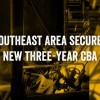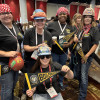Our great country was built on the backs of our highly skilled union workers, union skill, union pride and union craftsmanship.
Ron Traxler, Executive Director of the National Association of Construction Boilermaker Employers, shares results from NACBE’s annual safety index.
View Photo Gallery (6 photos)
A rise in energy consumption generated by artificial intelligence data demands, a ramp-up of U.S. Navy shipbuilding, innovative building technology in small nuclear reactors and other factors offer new job opportunities well-aligned for Boilermakers to seize now and in the near future. Organizing, recruiting and training are critical to ensure union Boilermakers can quickly man the jobs.
Under the theme “Organizing Our Future,” those topics headlined the 2025 Construction Sector Operations Conference, where Boilermakers, contractors and owners met to explore industry updates, work opportunities and more, March 31 to April 3 in Miami Beach, Florida.
“With industry changing at such a rapid pace, we must utilize every opportunity to build relationships, to capitalize on work opportunities within our industry and, equally as important, to seek ways to better communicate with each other,” said International President Timothy Simmons in his opening remarks. “We are increasing our training, we are increasing our skill sets, we are increasing our education, while at the same time maintaining the integrity and craftsmanship that you have been able to rely on in the past.”
Testament to industry changes and the hunger for more energy production, Tennessee Valley Authority Vice President of New Construction Bryan Williams gave an overview on growth, new builds, and re-issuing projects throughout TVA. He said the biggest growth comes from AI data centers.
“The point is that we’re growing and growing and growing, and so we’re building and building,” Williams said. “[There are] Thousands of megawatts under construction, right now, board approved all to be online in the next three years.”
In another big Boilermaker work opportunity, Captain Edward Bartlett, founder and CEO of Bartlett Maritime Corporation, talked about the U.S. Navy’s call for an accelerated build-up of the nation’s defense vessels—and Boilermakers’ roles in filling shipyard jobs with skilled welders. He described it as an “all hands on deck” effort to man the work.
He noted that the U.S. is supposed to have 66 attack submarines, four guided missile submarines and 14 ballistic nuclear submarines, and there are currently only 48 attack subs. While there are four guided missile and 14 ballistic nuclear submarines in service, they are getting old and replacements need to be ready so they can be retired. As shipbuilders have struggled to keep up with a five-fold increase in demand, he said, there aren’t enough welders and skilled trades to get the job done.
“We need to build rugged, highly capable great ships for the crews that are going out today, because you don’t know when they’re going to be called upon,” Bartlett said.
Last year, the Boilermakers and BMC signed a national labor agreement to build a rotational workforce of skilled welders. With help from the Boilermakers, BMC is piloting and developing the rotational workforce system, which invites qualified union welders to fill gaps in labor needs in U.S. shipyards. Construction Sector Boilermakers, for example, who are between jobs anywhere in the country can essentially boom out to a shipyard for work for a set period of time. The program is currently in place with Boilermakers as part of the workforce building the U.S.S. Enterprise in Newport News, Virginia.
“We’re ironing out the kinks [in the program], but this is not a one-off, and it’s worth the effort,” Bartlett said. “Our great country was built on the backs of our highly skilled union workers, union skill, union pride and union craftsmanship. Your skill, experience, passion, pride and hard work is building a monument to your craftsmanship that will live for decades to come.”
If the rotational workforce program is successfully manned by Boilermakers, it will lead to steady work opportunities for Construction Sector Boilermakers throughout the U.S. for many years.
“This is a new step forward for us as an industry,” said IP Simmons. “This will increase our man-hours, help strengthen our pensions, our annuity and everything we need to grow in this organization.”
Small Modular Reactors also present new, steady work potential for Boilermakers. Aecon’s Jason Campbell, Director of Labour Relations, and Mark Phillpotts-Delisser, Construction Manager, showed illustrations of new technology that makes building SMRs safer, more ergonomic for workers and more efficient as interest in SMRs grows. Campbell called for union Boilermakers to be ready to build them.
“What we want, and what we know we’re going to get, is a qualified worker from the hall,” he said.
He noted the importance of on-the-job learning and mentorship in working with the new SMR building technology: “You’re going to send us a trained worker and we’re going to send you back someone who’s maintained that training and also developed some other skills so they can mentor the next person.”
One program in development to prepare Boilermakers and boost recruiting is near ready for piloting in the Western States. General Manager-Western Operations for B&W Ed McWhorter and IVP-Western States J. Tom Baca gave an update on the Western States’ Readiness To Work program and other initiatives the area is prioritizing.
The Readiness To Work program will be a web-based app and desktop portal program that centralizes the safety and training requirements for all facilities in the Western States. Plans are for the program to also include skill-based training and integration with existing platforms to assess who is ready to go to work and what training is needed. To encourage Boilermakers to complete the necessary training to be job ready, the program also aims to provide some financial reimbursements.
McWhorter also shared ways employers, contractors and Boilermakers are partnering for success in the Western States, including targeting work using the M.O.R.E. Work Investment Fund and memorandums of understanding and developing a uniform regional M.O.R.E. Work Recovery Agreement—which has resulted in over 500,000 additional man-hours—as well as executing work using a single agreement across neighboring regions.
He and IVP Baca talked about how the Western States and Southeast Area collaborated to address the challenge of creating a single agreement for the El Paso Electric jobsite that spans two states—New Mexico and Texas—in two different regions and with different benefits packages in effect.
The issue, McWhorter said, was “How do we present to the owners that we are ‘one.’” While it took time and a lot of careful work between two Boilermaker areas listening to the employer, he reported that an agreement was reached and “it’s paying dividends.”
“We are all intrinsically tied to each other in the same goals and objectives,” he said. “Success begins by collaborating beyond what is conventional.”
Consultant Mike Murphy, echoed this as well in his discussion about the future of energy generation: “These unprecedented demands require immediate collaboration.”
Of course safety is always the priority of all Boilermaker work. Ron Traxler, Executive Director of the National Association of Construction Boilermaker Employers shared results from NACBE’s annual safety index.
NACBE has celebrated its 50th anniversary over the past year, and Traxler said collaboration has been key to the organization’s success in improving safety results.
“When we think about collaboration, it goes beyond just talking about the plan,” he said. “Together, through open dialog and shared resources, we can build resources that lead us into a brighter future. Together we can make something extraordinary.”
Also of special interest to Construction Sector Boilermakers, Pat Becker, Technical Leader at the Electric Power Research Institute, explained the difference between codes, standards and regulations in the industry—and why they are all integral to successful and safe Boilermaker work. She stressed the importance of asking questions to understand how and why practices and regulations are set.
“If you don’t know the reason,” she said. “You should ask the question. Knowing ‘why’ you do something is very beneficial and might come into play another time later.”
Joel Amato, Executive Director, National Board of Boiler & Pressure Vessel Inspectors, gave insight about NBBPI’s history. The board was established in 1919 in response to boiler explosions that were killing people. Beginning with 12 chief inspectors in Columbus, Ohio, the board was created to set uniform standards to ensure safety and to inspect boilers in operation. Today, the board maintains registration data on 72 million units, and NBBPI trains, certifies and provides accreditation for inspectors. They also operate one of two existing labs in the world licensed to conduct pressure relief valve testing and certification.
In other informational updates, AAIP and Executive Director-CSO Anthony Howell presented a Boilermakers Construction Sector status. Director of Government Affairs Cecile Conroy gave insight on the current national political arena’s impact on Boilermaker work and the labor movement. Western States consultant Erin Lehane discussed political measures relative to Boilermakers in California. Director of Jurisdiction-CSO Marty Stanton and Director-CSO-Canada Jonathan White talked about Boilermaker jurisdiction and assignments in the U.S. and Canada.
Further updates came from Mark Wertz, Boilermakers National Apprenticeship National Coordinator and Shon Almond, Director of the National Transient Division.
Additionally, j’Amey Bevan, Director of National Training Canada gave an overview of Canada’s robust training initiatives. Director of Health & Safety, Mark Garrett, and Director of Health & Safety-Canada, Jason McInnis, both discussed key issues affecting Boilermakers’ physical and mental well-being.
William “Bill” Miller, Chairman and CEO of the Bank of Labor, shared about the bank’s 100-year history and its commitment to working people and the labor movement.
The conference also included IVP-area break-out sessions, IVP area reports and informational sessions exclusively for Boilermaker attendees.

We are all intrinsically tied to each other in the same goals and objectives. Success begins by collaborating beyond what is conventional.











